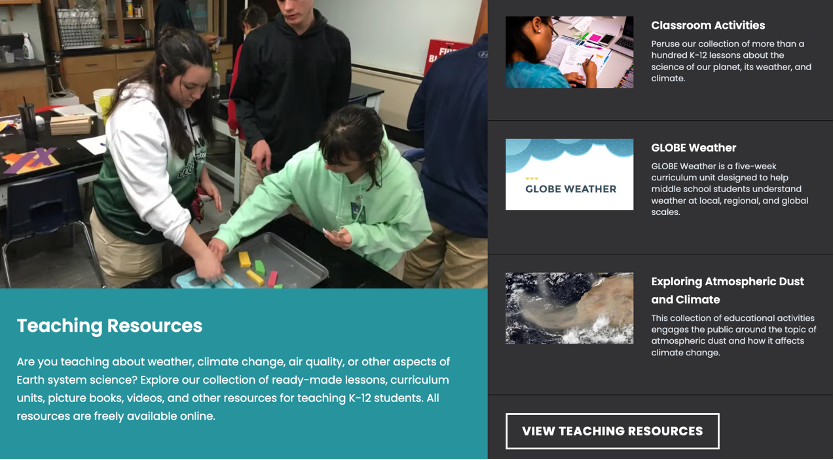
Collaborator Spotlight: Appreciating the Atmosphere with UCAR Center for Science Education
Understanding Earth's atmospheric and weather systems is a crucial part of knowing how to approach the many challenges presented by our changing climate. The UCAR Center for Science Education (UCAR SciEd) creates interactive educational resources covering topics in atmospheric and climate science—such as hurricanes, cloud formation, and greenhouse gases—for learners of all ages. Learn more about the organization's work from Robert Payo, Education Designer and Team Lead for Mixed Media Learning at UCAR SciEd!
What does UCAR SciEd do?
The UCAR Center for Science Education serves the geoscience community by amplifying and complementing the work of the U.S. National Science Foundation National Center for Atmospheric Research (NSF NCAR) and University Corporation for Atmospheric Research (UCAR) member universities by reaching our audiences: K–12 educators, university faculty, students, and the public through excellence in educational programs and experiences.
What's one fun fact that readers should know about your organization?
UCAR SciEd is a small, but mighty team of people with expertise in the atmospheric and related sciences and science education. We are passionate about our mission and strive for excellence in all aspects of our work. Our staff develop educational resources for K–12 classrooms and informal learning, exhibits used by school and public visitors at the NSF NCAR Mesa Lab Visitor Center, in-person and virtual programs for students, and undergraduate student and faculty mentoring programs.
What motivates you to work in science education?
I love to learn and am always curious to learn more. I’m always learning something new in this job and I really, really like that. Science is a way to discover things and figure out how things work, how things are connected to one another. I also enjoy helping educators find ways to make science come alive for their students.
Which UCAR SciEd content are you most proud of?
The Learning Zone is a free and accessible online hub for short articles, interactives, classroom activities, images, and videos to help you learn how the Earth works. Students, teachers or anyone who is curious can go to the Learning Zone to grow their knowledge of weather and other Earth system science topics. It’s also a great place to learn about climate and climate solutions.

We get spikes of increased visits to our website when events like solar eclipses, or the aurora borealis, or when an upcoming storm prompts people to learn how hurricanes form. It makes me proud to know that people are coming to us to find answers to their questions. News outlets also periodically quote and reference our content. One of our most popular resources and my personal favorite is the Name That Cloud Game. It’s a fun and interesting game—and who doesn’t like clouds?
- In addition to the Name That Cloud Game, explore other interactives from UCAR SciEd about hurricanes, thunderstorms, and snowstorms on LabXchange!
How can learners and educators best use your content?
Educators can find over 100 K–12 classroom activities as well as images, videos and interactives. If you go to our Teacher Resources page, you’ll also find curricula and other materials for teaching. We also provide teacher professional learning, both virtually and in-person with archived recorded sessions.
Since UCAR SciEd is a free and trusted resource for information, teachers can assign their students to go to the Learning Zone to read and learn about Earth system topics to build their background knowledge. I’m always going back to pages in the Learning Zone to help my own understanding! Finally, we encourage our users to send us comments if they have questions about our resources and we strive to get back to them with prompt responses.

What does UCAR SciEd have planned for the future?
We’re constantly collaborating with partners to develop new resources and building on existing ones. Currently, we are developing new resources related to severe storms, creating activities for the National Ozone Garden Network, and we just recently developed a tutorial for teachers on how to use data visualization tools with students to investigate climate impacts.
Finally, what's your favorite science joke/pun?
A photon walks into a hotel to book a room. The front desk attendant asks, “Any luggage?”
The photon replies, “Me? Nah, I’m traveling light!”
Explore more content from UCAR SciEd in the LabXchange library:
- Atmospheric Chemistry Memory Game (interactive)
- Virtual Ballooning to Explore the Atmosphere (simulation)
- The Nitrogen Cycle Game (teaching guide)
- Modeling a Weather Front (teaching guide)



.svg)

.svg)



